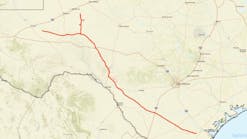Advancing seismic technology key to oil and gas industry future
The oil and natural gas industry places a high priority on advancing the frontier of seismic technology.
The rationale is simple: No other technology development in the industry’s recent history has had the kind of impact on finding and delineating new reserves that 3D seismic has.
So the quest continues for the next “magic bullet” in seismic technology.
At the same time, researchers persist in making incremental advances in existing seismic science, leveraging promising new technologies or optimizing traditional ones.
But pursuit of these quests comes against the backdrop of profound change within the industry.
Since the oil price bust of 1986, major oil companies have all but abandoned investment in research and development. That role has fallen largely to service companies.
In the intervening years, the seismic services industry has shrunk dramatically through consolidation. The number of full-service geophysical vendors has fallen by about 70% in the past decade.
The number of active seismic crews has plunged in parallel with that trend. From a peak of 744 at one point in 1981, the US seismic crew count fell to a record low of 37 at a point in 2003. While drilling activity has rebounded in response to higher oil and gas prices-with the US active rig count climbing to an average of almost 1,600 for first half 2006, up from about 1,300 the same time a year ago-the US seismic crew count has remained somewhat moribund, hovering in the 50s the past 2 years.
The seismic industry also must contend with a constantly shifting business model. For years, seismic applications focused on oil and gas exploration. As costs have fallen sharply and computing power and processing capabilities have multiplied exponentially, seismic contractors have found their business shifting more toward reservoir characterization. This trend dovetailed with operators’ shrinking pool of prospect opportunities-created largely by political barriers-and with their Wall Street-influenced growing focus on adding reserves through acquisition and production optimization.
Recently, however, high commodity prices in tandem with declining reserve replacement rates have led operating companies to rethink their own business models. It isn’t that the seismic-business pendulum is swinging entirely back to an exploration focus. It’s that operating companies today must embrace seismic applications to both find and produce more oil and gas in areas with increasingly hostile environments and more challenging subsurface geology.
Seismic service companies are recovering from the doldrums of the past 2 decades as demand for their services has rebounded. Yet they continue to grapple with pressure from operating companies to keep a lid on costs as they strive to market their services as increasingly important in reducing risk throughout the exploration and production spectrum.
Goal: quality plus cost
All of the geophysical industry experts interviewed for this supplement agreed that the primary shared goal for both operator and contractor is to improve industry’s ability to produce a clearer image of the subsurface in a cost-effective, environmentally sound way.
And they agree that the key to achieving that goal is new technology.
Mike Bahorich, Apache Corp. executive vice-president for exploration and production technology, sees three core cost-related aspects of seismic operations as the principal business drivers in advancing seismic technology.
“Quality, cost, and cycle time continue to propel seismic technology advances,” he says. “These three are very much related, as an innovation that cuts cycle time allows more to be accomplished per day, resulting in fewer hours and lower operating cost.
“As more seismic traces are acquired or processed, quality tends to improve. The largest financial benefit to operating companies generally occurs when quality takes a leap forward, allowing geoscientists to see and exploit what was previously undetected.”
The human element is the most critical one in advancing seismic technology today-whether it entails coping with the “brain drain” of recruiting and retaining geoscientists or motivating them to generate the ideas that advance that technology. This image of a geoscientist interpreting seismic data is courtesy of Petroleum Geo-Services ASA, Oslo.
Bahorich notes that as significant innovations surface and are utilized by the seismic industry, costs will come down.
“For example, innovations in large-volume flash memory chips have caused them to drop in price so dramatically that they are now cost-effective to separately record individual seismic traces in the field,” he says. “This enabling technology allows the manufacture of independent, cableless, single-channel recording systems that are easily scalable to very large channel counts-critical for high-resolution imaging.”
Bahorich also notes the innovations in parallel computing that continue to drive down prestack depth migration costs, allowing this technology to become available to more projects.
But the biggest barrier to advancing seismic technology is not a cost or technology issue, but a human one, according to Bahorich, a former president of the Society of Exploration Geophysicists: “Humans do not always embrace change. As busy as we are today, it is not easy to take the time to learn something new in order to increase productivity.
“Sharpening the saw needs to be done from time to time, and there are plenty of new technologies coming down the pike that will make our industry more productive.”
Personnel issues
Another critical human issue in the seismic industry-one critical to the advance of technology as well as to the future health of seismic contractors-is fending off the “brain drain” that continues to afflict all of the petroleum industry.
“Today, the biggest issue is finding the right people,” says Thierry Pilenko, CEO and chairman of Veritas DGC Inc., Houston. “You have to have the ability to identify the right people, to recruit them, and to retain them.”
He contends that Veritas has been lucky because over the years it has emphasized overinvestment in staffing. In particular, the company found good recruiting opportunities during the megamergers of the 1990s, when widespread layoffs resulted in a substantial pool of quality staff becoming available.
Pilenko also points to Veritas efforts to recruit geoscientists from “unconventional” sources.
“Sometimes, you have to stretch yourself” to attract quality personnel,” he notes. “We have had excellent results recruiting from such places as China, India, Eastern Europe.”
In the final analysis, while advancing seismic technology is the key to the oil and gas industry’s future, proper nurturing of the human element will be what turns that key.


